by Winding Pathways | Mar 11, 2021 | (Sub)Urban Homesteading, Birds, Pests
Millions of people love their cats. Some 36% of households keep an average of two cats. They are the second most popular companion animal in the United States, lagging only behind dogs.
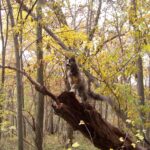
Cats decimate bird populations.
Some cats cause problems, especially when owners allow them to free-range the neighborhood. According to the American Bird Conservancy, they kill 2.4 billion birds a year and may be a significant cause of the decline of many species.
Catios to the rescue!
A growing number of cat lovers, many who also enjoy bird watching, recognize the problem and are increasingly adding a catio to their home. Wonder what it is???? It’s simply an enclosure that allows the family cats to enjoy fresh air, sunshine, and a bit of adventure without allowing them complete access to the neighborhood.
Many catios are enclosed patios, which spawned the name, that let cats play outdoors while their owners enjoy lounging or socializing nearby. They are relaxing places for both species. Other catios are small and positioned outside windows. Catios can be either purchased or homemade and often an existing patio can be modified into one.
Safety First!
Although cats love roaming the neighborhood, it is not a safe place. They pick up ticks and transfer them to humans, suffer accidents, are killed by cars as they cross streets, and are taken by predators.
A catio is a good solution to several problems. It allows cats to enjoy the outdoors safe from cars and predators in a place where they can’t kill birds. And, the owners always know where their cat is.
Harmony
An array of catio photos is visible on Catio Spaces. Many other websites feature them. Catios are a great way for cat lovers to show care of wildlife species, keep their cats safe, and live in peace with human neighbors who are frustrated when they spot a feline stalking birds under their feeder.
by Winding Pathways | Feb 25, 2021 | (Sub)Urban Homesteading, Garden/Yard, Garden/Yard, Nature
November 5, 2020, was a perfect day for burning our prairie. We’d enjoyed several days of dry weather, and had our fire permit. We just needed a bit of breeze.
On that gorgeous day we burned the labyrinth, the backyard prairie, and our savanna…….and then we struck a match into our newest prairie. With the help of Linn County Roads and Air Pollution Departments, Pheasants Forever, the Monarch Research Project, UNI, and Sustainable Landscape Solutions we had prepared the soil and killed the weeds last May. Then we broadcast a native seed mix containing 82 species.
Prairie’s slow to start. We didn’t expect much this first year and ended up with lots of crabgrass. It grew to about 8” and dried out nicely. A slow fire removed most of it, allowing sunshine to warm prairie plants beneath. We expect a resurgence of delightful plants next spring and summer.
-
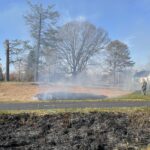
-
We burned the new prairie to encourage the native plants.
-

-
Several organizations and businesses are collaborating to create and manage the prairie.
by Winding Pathways | Feb 18, 2021 | Birds, Geology/Weather
As we ate breakfast during the deep freeze that descended on February 7th six wild turkeys trudged through the snow from nearby woods and feasted on corn scattered under our bird feeders. It was 20 below zero – genuine 20 below. With the wind chill, the air was even colder.
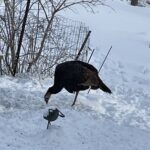
Warming toes.
The turkeys each stood on one leg as they pecked corn. Every once in a while, they alternated legs. One leg was always holding the bird upright while the other was tucked in the bird’s feathers. We wondered how they do this, so we went to our favorite new bird book, David Allen Sibley’s, What It’s Like to Be A Bird. According to him, birds have several adaptations that make it possible.
Here’s what he wrote, “The center of mass on their body is below the knee and a knob on the pelvis prevents the leg from angling any higher. Balancing on one leg requires angling that leg so that the foot is directly below the body, and with the leg essentially locked in position, and the body leaning against the leg, tiny adjustments of the toes are all that’s needed to stay upright.”
We often wonder how ducks and geese keep their legs and feet from freezing when swimming in frigid water or standing on ice. They have a useful adaptation. A bird’s leg is high, muscled, and covered with feathers. What we see that looks like a naked leg is actually a modified ankle, containing bones and tendons yet lacking blood vessels. So, the vascular area remains warm beneath feathers as the bird stands on the ice.
David Allen Sibley
We had the good fortune to chat with David Allen Sibley after he gave a presentation at the Outdoor Writers Association of America conference a few years ago. An astute ornithologist, writer, and artist, his books on bird identification and behavior, and his tree identification book, are always close at hand in our home. We’ve learned much from him.
Birds Need Grit in Winter
Most bird species need to occasionally eat tiny pebbles. These end up in the gizzard, a powerfully muscled pouch, where pebbles act like grindstones reducing hard seeds into a slurry for digestion.
During periods of snow and ice birds have a tough time finding grit, so about once a week we toss grit beneath the feeders. Sand works, but we usually use fine and medium-sized grit sold to help chickens digest their feed. Once the snow melts there’s no need to add grit, as birds easily find plenty of natural tiny pebbles.
-
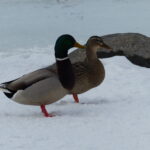
-
Adapted to the cold
-
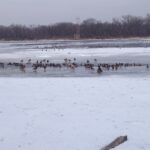
-
Weather adaptations
by Winding Pathways | Jan 21, 2021 | 1080 Labyrinth Blog, Garden/Yard, Gazette Features, Nature, Travel/Columns
Actually, 2020 has been incredibly busy for Winding Pathways writing in 2020. This winter we invite you to grab a warm beverage, curl up, and take in some of our features in the Cedar Rapids Gazette.
December 20, 2020. Walking Cemeteries. https://www.thegazette.com/subject/sports/outdoors/a-peaceful-outdoor-walking-option-20201221
December 14, 2020 Iowa Meat Lockers: https://www.thegazette.com/subject/sports/outdoors/a-meaty-adventure-20201214
Nov 11, 2020 Iowa’s Inland Seas. https://www.thegazette.com/subject/sports/outdoors/enjoying-iowas-inland-seas-20201111
Sept 27, 2020: New Life to dead Trees. https://www.thegazette.com/subject/sports/outdoors/dead-trees-give-life-20200927
September 20, 2020: Walk Outside Safely. https://www.thegazette.com/subject/sports/outdoors/get-outside-and-walk-but-stay-safe-20200920
September 9, 2020: Rebirth Amid the Rubble https://www.thegazette.com/subject/sports/outdoors/a-rebirth-among-the-rubble-of-trees-20200906
August 22, 2020: Iowa’s National Parks. https://www.thegazette.com/subject/sports/outdoors/iowa-national-parks-guide-effigy-hoover-20200822
July 27, 2020: County Parks. https://www.thegazette.com/subject/sports/outdoors/take-advantage-of-iowas-county-gems-20200727
July 11, 2020: Tenting. https://www.thegazette.com/subject/sports/outdoors/why-rv-live-isnt-for-these-senior-tent-campers-20200711
June 26, 2020: Bear Sightings in Iowa: https://www.thegazette.com/subject/sports/outdoors/why-rv-live-isnt-for-these-senior-tent-campers-20200711
April 12, 2020” Walk on Wilder side. https://www.thegazette.com/subject/sports/recreation/take-a-walk-on-the-wilder-side-20200412
by Winding Pathways | Dec 17, 2020 | (Sub)Urban Homesteading, Garden/Yard, Geology/Weather, Nature, Trees
We won’t forget August 10, 2020. On that summer day, Cedar Rapids was hit with 140 miles an hour winds that tore off roofs, felled signs, and toppled at least 65% of the City’s trees. The damage was awesome.
 We lost 47 of our 53 big trees at Winding Pathways and spent the next two months cutting up a twisted jumble of trunks and branches. We bucked up what we could for firewood and made huge brush piles on the north end of our property for wildlife habitat. We used chain saws for cutting but muscle power to haul brush and wood.
We lost 47 of our 53 big trees at Winding Pathways and spent the next two months cutting up a twisted jumble of trunks and branches. We bucked up what we could for firewood and made huge brush piles on the north end of our property for wildlife habitat. We used chain saws for cutting but muscle power to haul brush and wood.
Nearly all woodland owners suffered similar damage, and most of them immediately began clearing away broken and downed trees. Some used heavy equipment to haul off debris, leaving bare soil in the woods, a perfect seedbed for weeds.
Resetting the Forest
The derecho reset Iowa’s woods. Prior to settlement most of the state was prairie with woodlands typically lining streams and rivers. Frequent wildfires raced through grasslands and never hesitated when they encountered woods. This created a savanna ecotype characterized by scattered fire-resistant big trees, mostly oaks, walnuts, and hickories, with a stunningly diverse array of wildflowers carpeting the ground.
Savanna was an “open” forest. It lacked a shrub understory, and because trees didn’t create a closed leafy canopy sunlight dappled the ground. Perhaps no forest is as beautiful or endangered as savanna.
Iowa’s settlers quickly suppressed fire. Gradually trees closed the canopy, keeping the ground in shade most of the day. Many savanna flowers need some sunlight and declined as a shrub layer, often of exotic invasive woody plants, thrived. Many woods that owners considered healthy were actually degraded by years of fire protection.
The derecho changed it within under an hour. Many trees fell to the ground, but others survived. Woodlands will now have sunlight reach the ground, stimulating both invasive species and long-suppressed native wildflowers.
Planning and Planting
The woods on the east side of our house created nearly a complete canopy, but suddenly they fell. After we cleared away the debris, we did these things:
- Planted a few white and bur oaks in the fall. We’ll plant a few more next spring. All are protected from deer browsing with a stout ring of wire mesh.
- Purchased a diverse mix of savanna wildflowers and a few kinds of grass from Pheasants Forever. Mid-November brought two inches of new snow, and we hustled out to broadcast the seeds on it. It’s called frost planting and works well.
- Discovered some tiny oaks, hackberries, and walnuts amid fallen trees. We marked them and know they’ll grow rapidly next year.
Recovery will be slow. Newly planted trees grow slowly their first few years and savanna and prairie seeds take a few years to establish. We don’t expect to see much change in 2021 but our “new” savanna will eventually be gorgeous and look much like it would have in the early 1800s.
Sources
We bought our prairie seed from www.pheasantsforever.org. Our fall-planted trees were ordered from the National Arbor Day Foundation www.arborday.org. Spring planting will be of trees we bought from Chief River Nursery www.chief rivernursery.com.
-
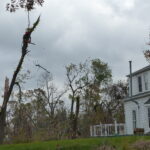
-
Trimming damaged trees.
-

-
Arbor Day in November
-
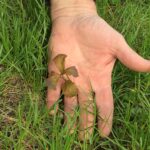
-
Discovering volunteer seedlings
-
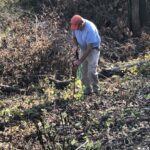
-
Rich planting acorns gleaned from an undamaged timber patch
We’ll follow up our planting with occasional prescribed burns to retard invasive plants and invigorate natives.
by Winding Pathways | Dec 10, 2020 | (Sub)Urban Homesteading, Garden/Yard, Nature, Trees, Trees/Shrubs
Unusual Storm Clouds
The August storm looked like an ordinary thunderstorm approaching. Dark clouds gathered to the west as we sat on our porch. What happened minutes later was far from normal.
The roaring wind hit like a prize fighter’s fist, bending our small oaks and maples parallel to the ground. Before it struck, we had 53 mature, healthy trees on our two acres. Forty minutes later only six still stood somewhat unravaged. As we watched in dismay and horror our oaks, hackberries, cherries, pines, and Douglas Firs either uprooted or snapped off. At least our beloved black walnut still stood on the edge of the woods.
Then a massive gust later reported to be 140 miles an hour by the National Weather Service, stripped off the walnut’s branches. Soon, the wind calmed, allowing us to see tree carnage and home damage. It was shocking and started three months of clean up and reconstruction. We fixed the house but it’s not possible to replace century-old trees.
A Banner Day
In contrast to the August 10, 2020 derecho, Thursday, November 19 was a banner day.

Arbor Day in November
We had just received a box of trees from the National Arbor Day Foundation. After we tucked the oaks, maples, pines, and aspens into the ground we ringed them with a thick layer of wood chips and gave them a good drink of water. The chips came from massive fallen trees the City of Cedar Rapids ground up after the storm. Then we circled each tree with wire mesh to protect it from hungry deer. By afternoon we were tired but elated. We won’t live long enough to see our new trees as giants, but we gave them a good start.
Arbor Day Quality Trees
The baby trees looked great. It was our most recent purchase from the Arbor Day Foundation. Although inexpensive, they looked healthy and eager to grow. Even the bur and white oaks, which have robust and long taproots looked great.
In most places, Arbor Day is celebrated in late April. We’ll plant some more trees then, but we sat on our back deck on a warm November evening and enjoyed seeing our trees in their new homes. For us and our new trees, it was Arbor Day in November.
Lied Lodge and Arbor Day Foundation – Destination
We have visited the Arbor Day Foundation in Nebraska City, Nebraska, several times. It’s where Arbor Day was created. We’ve overnighted at Lied Lodge on the property and enjoyed walking trails on Arbor Day Farm.
So, if you need to buy trees check out arborday.org. Want a pleasant place to visit? The Farm and Lodge are less than an hour’s drive south of Omaha. Although we’ve been there several times, we look forward to returning.

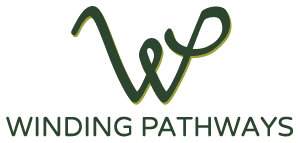





 We lost 47 of our 53 big trees at Winding Pathways and spent the next two months cutting up a twisted jumble of trunks and branches. We bucked up what we could for firewood and made huge brush piles on the north end of our property for wildlife habitat. We used chain saws for cutting but muscle power to haul brush and wood.
We lost 47 of our 53 big trees at Winding Pathways and spent the next two months cutting up a twisted jumble of trunks and branches. We bucked up what we could for firewood and made huge brush piles on the north end of our property for wildlife habitat. We used chain saws for cutting but muscle power to haul brush and wood.


